Text
Race Review: Wymeswold Waddle 2017
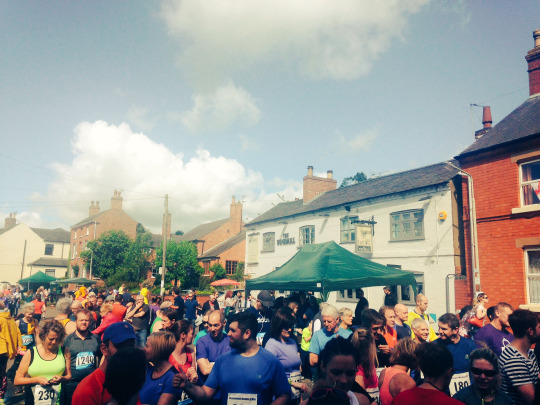
Date: 14th May 2017
Race: Wymeswold Waddle 2017
Distance: 5 miles
Time: 37.22
Position: 75/304
On Sunday I completed my first ‘competitive’ (NB I use the word in the loosest sense) race in what feels like eons. As regular readers of this blog will appreciate, my preparations have been stuttering to say the least, with an enforced six-week layoff followed by a period of gradually returning to some semblance of normality.
The event could be best described as an undulating out-and-back five mile course on a rural country road, with a village fete attached. This is a unique part of its charm, making it a now permanent fixture in my running calendar. The small-scale community feel to the event (the race numbers are collected from outside someone’s garage) belies its slick organisation, with chip timing, a commemorative t-shirt, and obligatory bottle of water (and Freddo).
As the name suggests a number of runners embrace the atmosphere by donning duck outfits, whilst there is an abundance of local running club vests on display, illustrating its appeal. For the second consecutive year the weather is ideal for spectators, as well as attracting a number of village stalls where you can choose a duck for the afternoon’s duck races, as well as tombola etc.
Turning to the race itself I endeavoured to use last years’ experience to avoid going out all gun’s blazing, but to maintain a steady pace for the outward leg before trying to incrementally increase the pace as I headed back towards the village. This strategy worked to an extent, meaning I could kick for home with the finish line and the supportive crowds looming in the distance.
Apparently the PA announcer had earlier declared that yours truly finished fourth, but disappointingly this was a case of mistaken identity. Looking back, my time of 37.22 was considerably slower than previously (36.35) but both satisfying and enjoyable nonetheless. Perusing the comments on social media afterwards it appears there were some teething problems with the commemorative t-shirts running out for the later finishers, but otherwise this is an excellent event. Recommended.
1 note
·
View note
Text
Perspective

Running is something I never want to take for granted. It’s a most-days-of-the-week thing, yes. Routine. Menial. Effortless, to most. But for me, a gangly, asthmatic forty-something, fresh from a protracted layoff, I appreciate how hard I’ve worked to be able to run a few miles without my legs and lungs screaming, repeatedly stopping to pause my Garmin as I take in a few precious gulps of air, scrambling for my inhaler.
And other times, just putting one foot in front of the other resembles a kind of therapy. Cathartic. A means of uncluttering my endlessly chattering brain.
The ritual of running either to or from work is slowly returning as I seek to get my focus back. I still clasp the same noble intentions of eating more healthily and to cut out the evenings of grazing sat in front of the television or browsing Twitter, but translating these thoughts into actions is proving problematic. Just as more-often-than-not I succumb to a pastry-shaped breakfast, or lack the willpower to walk away from the cake selection when ordering my customary flat white.
So it’s time to give myself a purpose. To start setting some realistic goals, and to demonstrate some resolve rather than floundering. I just need to remind myself to be patient. At present running feels like it did years ago when I was a beginner, only this time I’m conscious of what my body is capable of in terms of distance and speed, which is proving a continual source of frustration.
It’s time for some perspective.
0 notes
Text
Running withdrawal
Everything was going swimmingly. In February I proudly amassed 184.8 miles without going batshit crazy with long distances. Merely running most days, sometimes twice, though admittedly without a foam roller or an elaborate set of dynamic stretches in sight. And then disaster struck. Last month my milometer totalled zero. Nada. Zilch. The reason for this dramatic decline, a fateful morning run-commute which lasted only a few yards. My abdomen yelled in excruciating agony. Shooting chest pains, leaving me bent double, struggling to walk let alone jog. The intense sense of discomfort lessened as the hours passed, but I was still grimacing a few days later. No more parkruns, no more run-commuting, no more endorphins. I’d been relegated to the non-runner’s corner, longingly eyeing other runners and reading their endeavours with more than a hint of jealousy and frustration.
To read the rest, visit the Good People Run blog.
http://goodpeoplerun.co.nz/coming-to-terms-with-injury-as-a-runner/
2 notes
·
View notes
Text
Perception of a Runner
How is running depicted in popular culture? Read my latest musings on the Good People Run blog.
http://goodpeoplerun.co.nz/is-running-becoming-a-lifestyle-phenomenon/
0 notes
Text
Parenthood and Running
My article on parenthood and running is now online at Good People Run. To find out about this dramatic learning curve and the bumpy road of transition to becoming a running Dad click on the link below.
http://goodpeoplerun.co.nz/parenthood-and-running/
0 notes
Text
A Year on the Run (book review)

I must confess that nowadays I struggle to manage much in the way of reading for pleasure, as evidenced by the heaving bookshelves of as yet untouched crime fiction that my parents regularly lend. It is therefore testimony to both the bite-sized nature and peculiarly addictive qualities of Damian Hall’s A Year on the Run that has managed to sustain my interest for the last few evenings. The premise behind the book is surprisingly simple. AYOTR travails through the calendar year, each day recounting a single running-related story from it. Entries narrate record-breaking distances, historic career-defining victories, infamous incidents, and inspiring feats of human virtue and endurance. As one would rightly anticipate, a proportion of these resemble a who’s who of running legends with the likes of Emil Zatopek, Haile Gabrselassie, Paula Radcliffe and Scott Jurek represented. These are alongside anecdotes about unusual running events, such as the brilliantly titled ‘Knacker Cracker’, the gruelling Barkley Marathon (which since its inception only 14 runners have finished) as well as a spate of ‘freak races’ in the seventeenth and eighteenth centuries which included a fishmonger running from Hyde Park Corner, London, to Brentford with 56lb of fish on his head in 45 minutes. Then there’s the fascinating individual accomplishments such as ‘Wily Wobbler’ Edward Weston who as a result of a lost wager trekked from Boston to Washington for Abraham Lincoln’s presidential inauguration, or the remarkable case of Plennie Wingo who walked backwards for 517 days, totalling 8,000 miles. Personally, it is the latter stories – the painstakingly researched and lesser-known curiosities – that gives AYOTR its foremost appeal. That and the striking and beautiful illustrations by artist Daniel Seex, each inspired by the stories told. As the back cover boldly claims ‘a sporting treasure trove of human endeavour’. Recommended.
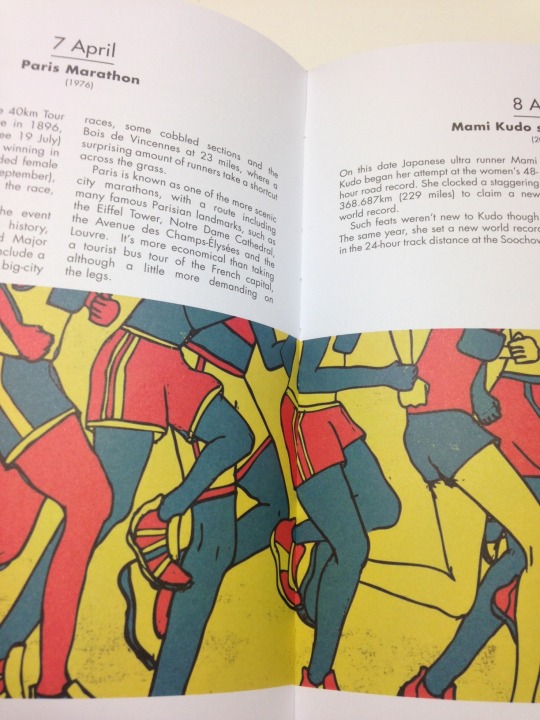
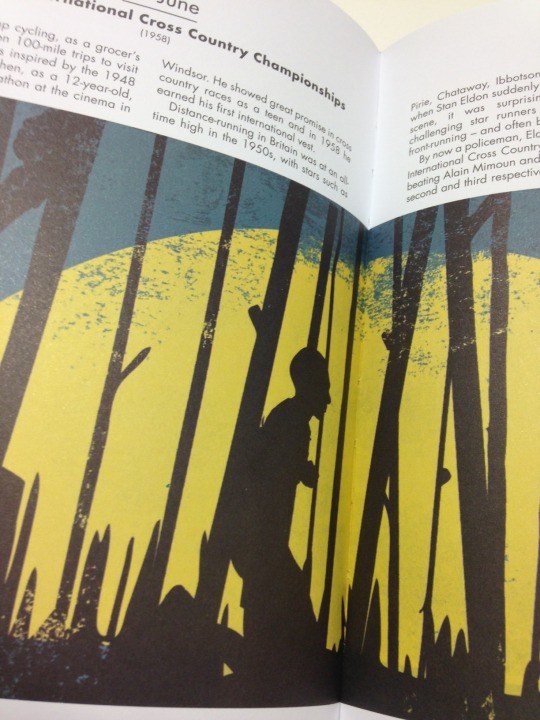
A Year on the Run is written by Damian Hall, with illustrations by Daniel Seex, and is published by Aurum Press.
0 notes
Text
Run! Run! Run! Biennale 2016 (a review of the Leeds leg)

Stripped to its barest essentials the act of running is remarkable for its stunning simplicity. The movement of putting one foot in front of the other. And yet such definition betrays its nuanced complexity, multiplicity of meanings and inbuilt contradictions. As John Bale opines, an “understanding of running cannot be achieved by simply looking at runners”. Of equal consideration is the socio-cultural context in which running occurs. Thus how might one critically interpret running as a political act of defiance in the hands (or rather feet) of women and girls in a conflict-affected region of Afghanistan, alongside privileged (predominantly male) Western fitness tourists testing their resilience, endurance and strength against the exotic extremities of the Saharan landscape in the Marathon des Sables? What can be learned or revealed from mobilising running to comprehend the experiences of refugees fleeing persecution and torture when juxtaposed with aesthetic displays of suffering in endurance sports through documentation in contemporary art?
This is the intentionally jarring backdrop to the opening leg of the triptych Run! Run! Run! Biennale 2016, which as curator Kai Syng Tan alludes is the darker ‘difficult second album’ following in the footsteps of the inaugural Run! Run! Run! International Festival of Running held in 2014. As with its predecessor, the purpose is to provoke conversations across different disciplines, in the process stimulating new research directions and creative collaborations to add to our existing understanding of, and fascination with, running. In particular, there is a noticeable bent towards exploring the relationship between the distinct spheres of art and sport, which admittedly to the lay outsider may not appear to be immediate bedfellows. And yet at various points during the afternoon I am reminded of the illustrator Leanne Shapton, who in her quietly profound memoir, Swimming Studies, observes “artistic discipline and athletic discipline are kissing cousins, they require the same thing, an unspecial practice: tedious and pitch-black invisible, private as guts, but always sacred”.
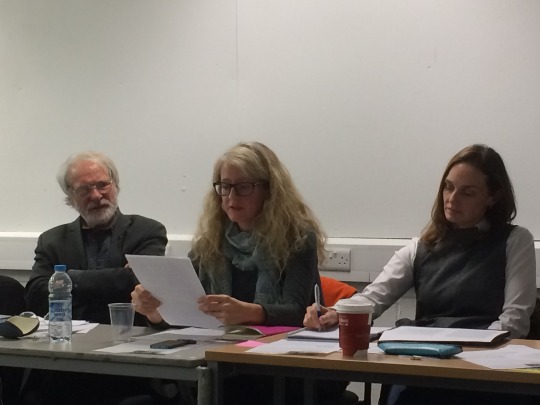
At this juncture it is worth emphasising that this ‘review’ of the Leeds leg is in no way designed to present an exhaustive running commentary of the events proceedings. For starters, my frenetic note-taking is unlikely to adequately capture, nor do justice to the energy and richness of the contributions. Instead, I shall endeavour to construct a personal narrative – a fleeting sketch if you prefer – to consider how chance juxtapositions spark new unities and converging paths, as well as reflecting upon some of the inherent disconnections.
A discernible starting point is the notion of (pushing) borders and boundaries, whether creative, geographical, or challenging the limits of the human body. These intersections are explored most notably in Karen Throsby’s paper which memorably conjures marathon swimming’s intense, isolating pleasures. Drawing on her (auto)ethnographic study, Karen uses the sport of swimming long distances as a conduit for thinking about mind-body boundaries (reflected in the ‘mind over matter’ rhetoric championed by the marathon swimming community) as well as the freedoms and privileges the sport demands, alluding to the resource-greedy nature of the leisure pursuit, as well the mobility and financial capital necessary to compete. There are notable linkages with Debbie Lisle’s less charitable depiction of the ‘bro-dog’ ultramarathon runner, seemingly motivated by a desire to conquer the forbidding Sahara Desert and a post-race career as a motivational speaker to multinational corporations. Our attention is drawn to the troubling reductive colonial encounters, with a handful of Moroccan endurance runners continuing to defeat year-after-year the most over-invested, hyper-equipped and highly trained ultramarathon runners.

This leads us to consider a complimentary theme, that of overcoming and/or suffering. The latter are at the forefront for any athlete, whether it means beating an opponent (or oneself and creeping self-doubts), achieving a faster race time, or coping with pain and injury. Writ large in Stephanie Case’s inspirational opening are the meanings and by-products derived from the defiant, public act of running. Her narrative is one of empowerment and transformation, using running, fitness and outdoor adventure programmes as an avenue to freedom, to foster social networks of support, and to help shift the perception of gender roles in war-torn societies where women and girls are disproportionately affected by conflict. We learn that Stephanie (aside from being a supremely talented ultramarathon runner) is the founder and volunteer President of Free to Run, a charity which champions the idea that running is significantly more than a physical act. Kai Syng Tan picks up this baton, teasing out the irony between the gruelling journeys that migrants undertake to seek asylum, and the pursuit made by ‘escapees’ of Europe seeking gruelling (and exorbitant) endurance challenges in the name of fitness, adventure and/or self-fulfilment.
For Lisa Stansbie, the fusing of sport with art enables us to investigate the narratives, processes, rituals and apparatus of endurance sports. She highlights the work of Dutch artist and triathlete Guido Van Der Werve to explore the synergies between the two disciplines (for example, physical effort, solitude, repetition, and boredom). Doug Sandle – founding Chair of Fields of Vision – adopts a similar perspective, providing an impassioned defence for marrying the potentially unlikely pairing of the artist and the athlete. He presents a number of anecdotes (from Brian Jungen’s sculptures crafted from Nike trainers, to Martin Creed’s Work No 850 for Tate Britain where volunteer runners were asked to make the 86 metre dash along the length of neo-classical sculpture gallery) to help illustrate the potential the arts have to celebrate, encapsulate and express sports practice and culture.

As the opening leg of the Run! Run! Run! Bienalle draws to a natural conclusion, from the resultant interdisciplinary conversations (and attempts to shrug off our academic silos) one cannot help but wonder, where do we go from here? As alluded to earlier, amidst the potential to identify aspects of common ground, the assorted line-up (or in Kai’s words ‘mix-and-mismatch programming’) invariably leads to incongruities and divergent paths. By drawing upon and navigating such diverse perspectives, the resultant challenge and blurring of these distinctions will hopefully provide further insights into the ways people understand the pursuit of running in their own lives. As Perrier and Bridel note “truly interdisciplinary work cannot give primacy to one discipline over another but rather strive to acknowledge and chip away at disciplinary silos that seem to have a kind of endurance of their own”.
*With thanks to Kai for the invitation and for supplying the images.
0 notes
Text
We are Tribe

The market in subscription boxes is flourishing. As Guardian journalist Paula Cocozza laconically writes “from dog treats to condoms, you name it, someone has boxed it”. Whilst I’ve dabbled in the past with deliveries of wholesome snacks, fresh coffee, and bottled craft beer through the post, each has ultimately proved to be short-lived, failing to maintain the early novelty and incentives, whilst being deluged with endless marketing e-mails.
Tribe, on the other hand, have retained their appeal and are now a permanent fixture. To the uninitiated, they are a small start-up brand, purveyors of nutrient rich snacks specifically aimed at endurance runners and athletes, whose pithy mission statement is “eat natural. Run free.” But in reality they are more than that, having successfully fostered a growing running community (more on this later), as well as boasting a laudable social ethos, with ten pence from each Tribe box supporting charitable fundraising projects.
Each distinctive Tribe box is thoughtfully (and stylishly) packaged, complete with a running-related quotation, and comes with a single A4 sheet newsletter. Meanwhile the pocket-sized snacks (which source organic ingredients wherever possible) are arranged under different types of training – Sustain, Plenish, Glow, and Pick me Up. In each box you’ll discover bars like sour cherry and buckwheat, alongside a packet of goji and bee pollen, or Scafell trail mix (cacao and banana) – all with the nutritional information clearly stated. What is more, all of the ‘tried and tested’ products contain no refined sugars or sulphates, are wholefood-based, GM-free and dairy-free.
Having relied on these for fuelling my recent NoMad 50K Ultra, I can confidently state that they lived up to all expectations. Admittedly I am someone with a delicate constitution, and so find consuming heavily processed gels and energy drinks on long runs something of a challenge. Not so the Tribe range, which merely adds to their appeal.
As aforementioned, Tribe is building up its running community, arranging regular events across London and beyond. For those living further afield looking on enviously, Tribe also sporadically organises ‘virtual’ challenges such as the Dawn Raid (a 7am run of 8K or more) whilst to coincide with the London Marathon, runners were tasked with running 26.2 miles over ten days. Each trial has its own incentives, usually discounts on snack boxes, or money off the stylish range of Tribe apparel.
So my advice is to give them a go, I can promise you won’t be disappointed. Tribe are often championing promotions via social media and on their website so it shouldn’t be too difficult to bag yourself a trial box at a bargain price.
Finally, a review disclaimer. I am a Tribe subscriber and received no incentive or commission to write this review. Heck, there wasn’t even a freebie involved.
0 notes
Text
Mangled feet

Last month I ran 162.8 miles, which is the distance between Nottingham and Newcastle-upon-Tyne. That’s a lot of (predominantly) pavement pounding, or 211,640 steps according to my back-of-an-envelope calculations using a formula developed by Hoeger et al. (2008). With every footfall imparting force and weight, this got me thinking about the impact on my poor battered feet, which after years of (ahem) running repairs, resemble a podiatrist’s nightmare. Mangled, blackened toenails have become staple features, along with blistered and calloused toes. Underfoot my soles are weather-worn, victim of traversing multiple terrains and surfaces. But then for the long-distance runner such abrasions are merely badges of honour, unavoidable scars accumulated from our frequent encounters with topography.
0 notes
Text
NoMad Ultra
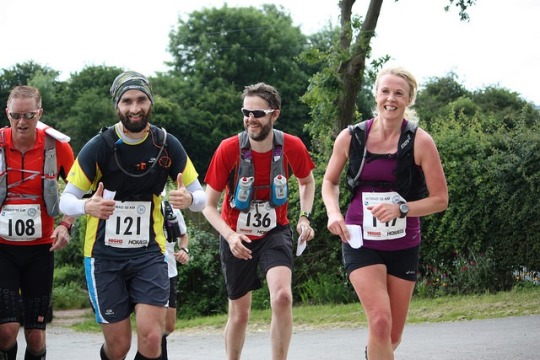
A smidgen over two years ago I made my maiden foray into ultrarunning, coercing my battered body around forty-something miles of Nottinghamshire countryside. Even before I hobbled over the finish line I’d enacted my own Steve Redgrave moment, vowing to never attempt a longer than marathon distance again. Such is the runners’ psychology - added to which sufficient time has lapsed for the memories of my contorted, screaming limbs to have faded - to consider having another stab. So on Saturday morning I set off from Breaston on the NoMad50 Ultra (note: the number reference is kilometres not the miles variety, although some hardy, intrepid types did opt for this) and to my mild astonishment, I bloody loved it. I wouldn’t go so far as stating it was an epiphany, but my experience has certainly changed my perception of ultramarathons for the better. Besides the faultless event organisation (more on that later) there are five aspects that undoubtedly contributed to the experience, which to fellow beginners I would tentatively offer up as words of advice or encouragement.
First off, there is a plethora of literature vying for the attention of the apprentice on how to run ultramarathons. Besides devouring Hal Koerner’s Field Guide to Ultrarunning, one of the nuggets of advice that really resonated with me came from Marco Consani who sagely purports “an ultra-race doesn’t really start until it enters the last third, so if you race the first half I guarantee that when you get to the final third you will feel like you’ve been shot”.
Second, for the navigationally challenged gpx files are a godsend. Due to my numerous wrong turns at the Dukeries ultra, the principal source of pre-race anxiety was whether I’d be able to successfully plot my way around the rolling Derbyshire countryside. Armed with the four stages of the 50K route downloaded to my Strava account meant that I didn’t once need to consult the reams of written directions (which probably weren’t legible anyway thanks to a couple of ferocious downpours), although the event organisers deserve a special mention for their attention to the route, pre-race recces and markers.
Third, I am now beginning to wonder whether I’ve been too preoccupied with calorie chasing and being fuelled up. When running long distances in the past I have struggled to remain hydrated, whilst digesting gels have typically led to excruciating stomach cramps. Besides setting off with a hydro-pack the only ‘fuel’ I consumed on Saturday was a handful of jelly babies, and a third of a Tribe bar. Happily as a result, no tummy troubles, nor any sign of a deficit.
Forth, an obvious one but assembling the right kit in terms of the basics (and using the equipment whilst on those LSRs) makes a difference. Harking back to the Dukeries 40-miler part of the problem was wearing trainers designed for road running rather than traversing multi-terrains, which on the day also happened to resemble a bog. This time I plumped for a pair of Brooks Cascadia 11’s, a supportive and versatile trail shoe. No doubt purists would shake their head at this choice, but they served the purpose.
And fifthly, ultra-running is above all a social experience. It’s a time (forgive the pun) to cast the Garmin aside and not to get hung up on splits, or pursuing a particular goal. Rather it’s an immersive experience, chatting to fellow runners, as well as enjoying the surroundings. On the latter, the NoMad50 takes in some scenic rolling countryside with 605m climb with canal, trail, fields, and some road.
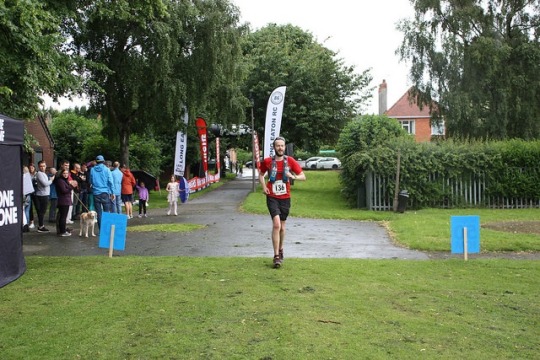
So would I recommend the NoMad50? The answer is a resounding yes. The organisers clearly share an enthusiasm for this annual event, and judging by the updates on Facebook have dedicated a considerable amount of time to preparing the course, including clearing stiles, treading down nettles and communicating a couple of last minute detours. And I haven’t even mentioned the super-friendly and supportive volunteers staffing the checkpoints, the race bling, and the added incentive (if any were needed) of real ale at the finish.
NB I have taken the photographs from the public Flickr page: https://www.flickr.com/groups/2779214@N25/
0 notes
Text
Hot to trot
After much deliberation, I’ve taken the plunge and upgraded my Strava account to the premium service. Amidst the befuddling array of additional features, which includes richer data, real-time analysis and training plans, there is a rather natty heat map function. The latter is a graphic representation of the GPS data, providing at a single glance the most commonly conquered paths, no matter how short or seemingly insignificant.

The downside to this visualisation (see pictured) is how humdrum my limited range of running routes has become, narrowly centred around my trusted run-commute, the occasional lunchtime sojourn, and Forest Rec parkrun. There is no doubt that with my trainers on I have become a creature of habit, bound by routine and a degree of functionality. On the flipside, perhaps seeing this data so starkly depicted it’ll spur me on to venture further afield, seeking virgin urban streets and routes for interesting new adventures. That or it could just make for dull desktop wallpaper.
0 notes
Text
Child’s play
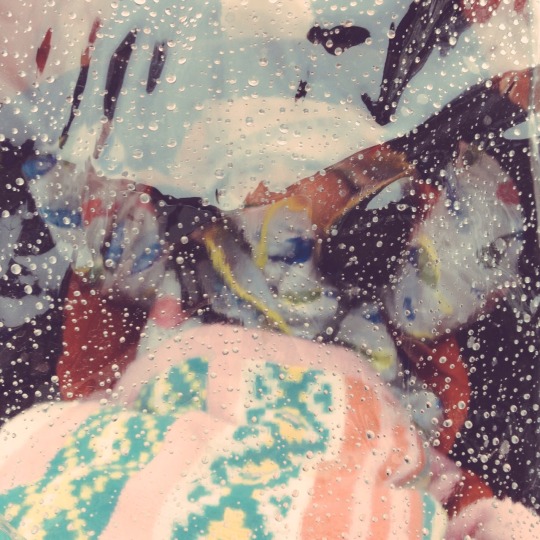
I’m ashamed to disclose that I am not a parkrun regular. Huddled with 109 others at the start line of the inaugural Forest Rec parkrun – handily located little more than a mile from my front door - I can vividly recall enthusiastically envisioning that a Saturday morning 5K would become entrenched into the weekend routine. Three years down the line and whilst fellow parkrun devotees are sporting a wardrobe full of milestone t-shirts, I’ve amassed a paltry twenty-four parkruns to my name. I could rattle off a list of mitigating circumstances – the stresses and pressures of our humdrum work-consumed lives, as well as the joys and challenges of being a new father – but these would just be excuses.
I’m hoping that I’ve now turned a corner.
After months of procrastinating, last weekend I finally took my fourteen month daughter Rowan to her maiden parkrun. In all honesty I should have done eons ago but was scarred by an underwhelming Santa Run which was characterised by a teary toddler who went into apoplexy upon spotting her mother at the start of the second lap and audibly made her preference for cuddles with Steph known to anyone within a mile radius. There has also been what feels like months of unimaginably early morning rises so that by the time 9am comes around nap time is beckoning.
Fortuitously last Saturday was a less eventful experience. Admittedly there were still a few disapproving groans, most notably at the beginning when we had to wait for the event team to complete their pre-run routine, but this was quickly replaced by excited chattering as the 5K got underway. More pleasingly by the second lap Rowan was fast asleep, oblivious to the compliments we were receiving from pram-less runners that were fulsome in their admiration for our endeavours, navigating the hilly Forest Rec terrain.
The aspiration is that this will now become a weekly feature. A chance to transform parkrun into a truly family affair, and a valuable spot of Dad-daughter time to explore the outdoors together.
0 notes
Text
Epic fail

*Sniff* So that was the month of November. An unmitigated disaster on the running front due in large part to the dogged persistence of a wheeze-inducing, mucus-generating cold. Maddeningly I managed just three run-commutes which totalled less than the required thirty three kilometres to register for Virtual Runner UK’s Poppy Challenge (or more specifically to be able to gain one of their strikingly designed medals). What makes matters worse – writing this on the eve of the AdventRunning challenge - is that there aren’t any signs of the illness abating, which isn’t helped by the prolonged absence of a decent night’s kip (scientists monitoring people’s sleep patterns reckon that if you clock less than seven hours you’re three times more likely to get sick than those who slept for at least eight hours). Suffice to say that none of the above stopped me from packing my running kit this morning in the naïve hope that I’d be able to miraculously shake off my winter woes and squeeze in a lunchtime run in the driving rain (needless to add, I didn’t).
Epilogue: please excuse the inescapable fact that these musings are more about the frustrations of not being able to exercise than the experience of running itself. Here’s hoping for an extended period when I’m not blighted by a soundtrack of chesty coughs and can finally don my running trainers.
0 notes
Text
Vote for me!

Well, what do you know? This humble little enclave in the blogosphere has been nominated for the 2016 Running Awards. I’m not entirely sure how or why, especially when you scroll down the list of the other nominees, but it’s still very flattering nonetheless. If you are a regular reader of this blog, it would be spectacularly lovely if you could spare a few seconds to vote for me in the ‘publications/online’ category. Thank you.
http://therunningawards.com/#vote
0 notes
Text
Awful race photos
If there is a single moment in a race which I dread the most, it isn’t during the run itself but days later when an e-mail gleefully arrives with a link to several thumbnail photographs documenting said event. The latter can transform what felt at the time a significant personal triumph into a colossal, soul-destroying comedown.
This isn’t meant as a slight on the budding David Baileys who I am sure are lovely people, who devote countless hours to snapping away and downloading thousands of images. It is more an observation on just how goddam awful the official race photos featuring yours truly are. Despite my best endeavours to channel my inner Mo Farah whilst smiling at the merest sight of a camera lens, I cannot recall any photographs from past events that I’ve been even in the slightest bit satisfied with or that I’d be willing to share on social media. And judging by the blog posts and online forums devoted to sharing your worst race photos, I am clearly not alone.
The collection of pictures following the recent Robin Hood Marathon were particularly hideous – a gallery of unflattering angles, dreadful posture, grimacing and unattractive facial expressions. Admittedly none of the images were helped by suffering a gel malfunction around mile fifteen when embarrassingly most of the contents splattered directly onto my face and hair. Such experiences are in dramatic contrast to the heavily stylised, photo-shopped images that populate the pages of mainstream running magazines.
But perhaps this isn’t necessarily negative. Shouldn’t there be more natural depictions of ‘real’ runners as opposed to the catalogue of models airbrushed to surreal perfection and not even breaking sweat, which sadly have become the norm? This kind of presentation of male and female athletes merely serves to perpetuate dissatisfaction with our bodies, whilst it is particularly noticeable how the ways in which running is portrayed on the cover of running magazines (effortless and desirable) is often in contrast to how it is presented inside.
I guess for the majority, the real problem is quite simple: we don’t look like world-class distance runners. No matter how much effort and expense we dedicate to resemble an athlete, with fancy, polarised sunglasses, and matching running shorts and top, most of the time our pained facial expressions, windswept hair, and being shot at a bad angle will contribute to yet another disappointing race photograph.
0 notes
Text
The Robin Hood Marathon (take 3)
Twenty nine seconds. Or put more colloquially, a gnat’s whisker. It was the tiniest of margins that squeezed Sunday’s run into the hallowed turf of the sub-four hour marathon. And my second quickest time to date.
This was the third occasion that I’d completed the Robin Hood Marathon, Nottingham’s annual mass participation race which incorporates a half-marathon and fun-run alongside those foolhardy enough to elect to navigate 26.2 miles around the cities’ streets. This year the event boasted a spangly new-look course, ditching some of the less attractive sections (such as a non-descript industrial estate and windy Holme Pierrepont) in favour of a hillier route, but one which features a greater range of local landmarks and a segment cutting through the heart of the city centre (more on this later).
If you’ve perused my previous blog post you’ll be aware that my own preparations could aptly be described as haphazard at best, with a paucity of long runs to ready myself – both physically and mentally - for the challenge which lay ahead. Fortunately I wasn’t alone (quite literally) as I was running with a friend and work colleague, Ian, for whom this was his first marathon. Having a companion to run with made this a dramatically different experience from what I am normally used to, which was particularly beneficial during the latter stages when we both chivvied and encouraged each other along.
What follows are a series of personal reflections from the day, which may or (more likely) may not be helpful to others contemplating a marathon, or indeed whether to sign-up for this particular event in future.
First off, despite having taken part in previous years, it is only on the morning that you begin to appreciate the scale of the event. The level of disruption, particularly to roads and public transport is immense, whilst finally arriving at the race village (situated on Victoria Embankment) you start to comprehend the number of participants, volunteers and spectators. In spite of this, the baggage tent is an impressive lesson in efficiency dealing with several thousand runners with a minimum of fuss. Unlike the portaloo situation, characterised by seemingly endless queues snaking their way around the site, leaving Ian and I (I’m ashamed to write) to seek alternative arrangements.
Personally I preferred the much-changed, albeit hillier, course for the marathon. The added ascents were worth it to incorporate more of Nottingham’s landmarks. That said, in terms of vocal support the section through the city centre was one of the most disappointing aspects, as most of the people congregated alongside the route appeared to be disgruntled shoppers, looking visibly miffed at the disruption the marathon was undoubtedly causing. This is a minor grumble however, as there were plenty of other points along the course where well-wishers were out in force. At this juncture the army of volunteers at Colwick Park deserve a special mention – it was great to see so many friendly and familiar faces – as well as the pocket of cheerleaders from Cancer Research UK who really gave me a boost.
The unsung heroes in events such as these are the scores of volunteer marshals and well-wishers lining the course, enthusiastically cheering on complete strangers as they shuffle their way round. On this point, if there is one recommendation I would make to the novice marathon runner is to have your name emblazoned on your running vest. Hearing people shout your name has magical motivational properties, which really adds to the experience.
Much is written about the demands of marathon running, as well as stacks of strategies to cope with its fatiguing effects. A recurring theme is to set yourself small goals rather than to allow yourself to become overwhelmed or demotivated by the enormity of the challenge. I borrowed a suggestion I had come across elsewhere, which was to have a pocket stuffed full of jelly babies and to commemorate each mile marker by devouring one. This helped me to stay in the moment rather than focusing on the distance, which is where the anxiety lies.
That isn’t to imply that consuming sweets is some sort of silver bullet. It never fails to surprise me how quickly your mood can change during the latter stages of a marathon. One moment you can feel fairly comfortable and relaxed, and the next minute, lethargy and darkness descends. Analysing my profile on Strava it is easy to identify where things started to go belly-up. Between miles 1-21 I had been churning out 8:30 minute splits with scary regularity. Then the times started to creep upwards, with the penultimate mile at 12:17, reflective of the amount of discomfort (and walking/laboured jogging) I was experiencing. Ian’s encouraging words, and those of the spectators en route, were invaluable – coaxing my tired limbs to persevere, and to keep putting one foot in front of the other.

Whilst considerable attention is given to the physical and mental aspects of the marathon, remembering to enjoy the actual experience, not to take it too seriously, and to run with a smile on your face are pointers which are often overlooked. Throughout the course I bellowed encouragement to fellow runners, as well as making a point of showing my gratitude to volunteers and well-wishers (in one case running across the road to ‘high five’ a huddle of supporters from Macmillan).
Finally, those motivated by race bling will undoubtedly be impressed by the finishers’ medal – a weighty object, boasting a striking stag’s head design. This more than compensated for the mediocre ‘goody bag’ which I can’t help but ponder why events such as these persevere with offering such items when most of the contents border on the next to useless.
So all in all, an enjoyable race, which has helped to rekindle my love of long-distance running. Roll on my next venture – the 16 mile Seagrave Challenge in November.
0 notes
Text
Back in the saddle

In a few hours’ time I shall be running the Robin Hood Marathon.
I can still vividly remember the assortment of thoughts and emotions in the build-up to my first foray into marathon running almost four years ago to the day. Aside from the obvious sense of excitement, the overriding sensation as I stood waiting at the starting line was one of mild trepidation and anxiety as I prepared to venture into the unknown.
It was the unfamiliar that was feeding my apprehension. Had my preparations been sufficient in readying my body and mind for the demands of running 26.2 strength-sapping miles?
The answer then is the same as it is now – a resounding no. Back then I was running almost daily, but had only registered a handful of runs over the ten mile mark. This time around my summer training has largely consisted of getting up about five o’clock to squeeze in a few LSRs before I needed to be home in time for breakfast with my daughter. Since the beginning of the month I’ve been able to resurrect the run-commute, which has helped get some more miles in the legs. Sixteen miles has been the longest distance, aside from a sadomasochistic three run day when I clocked up more than twenty miles, but also resulted in a ridiculously early night.
On the back of such haphazard preparations, I’m not going into tomorrow’s marathon with any great expectations, besides doing my best to enjoy it and hoping not to walk too many sections. For the first time I shall actually be accompanied by a friend, Ian, for whom it is his first marathon experience. Last time we ran together I managed a half-marathon PB so you never know …
0 notes